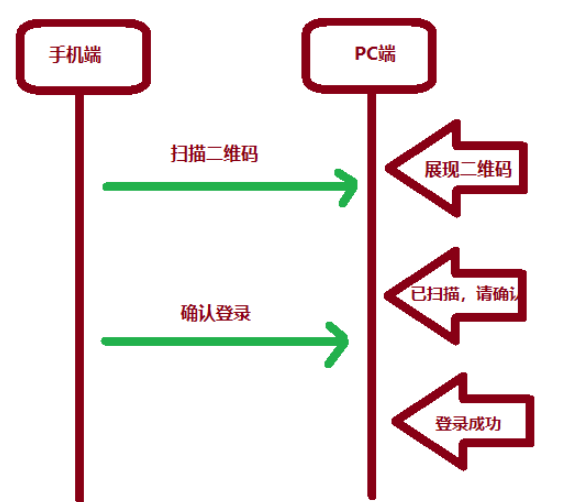本篇内容介绍了“SpringBoot怎么实现二维码扫码登录”的有关知识,在实际案例的操作过程中,不少人都会遇到这样的困境,接下来就让小编带领大家学习一下如何处理这些情况吧!希望大家仔细阅读,能够学有所成!
二维码扫码登录是一种基于OAuth3.0协议的授权登录方式。在这种方式下,应用程序不需要获取用户的用户名和密码,只需要获取用户的授权即可。二维码扫码登录主要有以下几个步骤:
应用程序生成一个二维码,并将该二维码展示给用户。
用户使用扫码工具扫描该二维码,并在授权页面中授权。
用户授权后,应用程序会获取一个授权码。
应用程序使用该授权码向授权服务器请求访问令牌。
授权服务器返回一个访问令牌给应用程序。
应用程序使用该访问令牌访问资源服务器。

通过以上步骤,二维码扫码登录可以实现用户的快速登录,并保证了用户的安全性和隐私性。
在SpringBoot中,可以使用Spring Security OAuth3.0来实现二维码扫码登录功能。Spring Security OAuth3.0是一个基于OAuth3.0协议的安全框架,它提供了授权服务器和资源服务器的实现。下面,我将为大家介绍如何使用Spring Security OAuth3.0实现二维码扫码登录。
添加依赖
首先,需要在pom.xml文件中添加Spring Security OAuth3.0的依赖:
<dependency> <groupId>org.springframework.security.oauth</groupId> <artifactId>spring-security-oauth3</artifactId> <version>2.4.0</version> </dependency>
配置授权服务器
在SpringBoot中,可以通过@Configuration注解来配置授权服务器。下面是一个简单的授权服务器配置示例:
@Configuration
@EnableAuthorizationServer
public class AuthorizationServerConfig extends AuthorizationServerConfigurerAdapter {
@Autowired
private AuthenticationManager authenticationManager;
@Override
public void configure(ClientDetailsServiceConfigurer clients) throws Exception {
clients.inMemory()
.withClient("client")
.secret("{noop}secret")
.authorizedGrantTypes("authorization_code")
.scopes("read", "write")
.redirectUris("http://localhost:8080/callback");
}
@Override
public void configure(AuthorizationServerEndpoints endpoints) throws Exception {
endpoints.authenticationManager(authenticationManager);
}
}在上面的代码中,使用@EnableAuthorizationServer注解来启用授权服务器。然后,通过@Configuration注解来指定该类为一个配置类。在configure()方法中,配置了一个授权客户端,并指定了授权类型为authorization_code。授权服务器通过inMemory()方法来指定客户端的信息,包括客户端ID、客户端秘钥、授权类型、授权范围以及重定向地址等信息。在configure()方法中,还需要配置AuthenticationManager,用于验证用户的身份信息。
配置资源服务器
在SpringBoot中,可以通过@Configuration注解来配置资源服务器。下面是一个简单的资源服务器配置示例:
@Configuration
@EnableResourceServer
public class ResourceServerConfig extends ResourceServerConfigurerAdapter {
@Override
public void configure(HttpSecurity http) throws Exception {
http.authorizeRequests()
.antMatchers("/api/**").authenticated()
.anyRequest().permitAll();
}
@Override
public void configure(ResourceServerSecurityConfigurer resources) throws Exception {
resources.resourceId("resource");
}
}在上面的代码中,使用@EnableResourceServer注解来启用资源服务器。然后,通过@Configuration注解来指定该类为一个配置类。在configure()方法中,配置了资源服务器的安全策略,使用antMatchers()方法指定了需要认证的接口,使用permitAll()方法指定了其他接口可以被匿名访问。在configure()方法中,还需要配置资源服务器的资源ID。
配置客户端
在SpringBoot中,可以通过配置文件来配置客户端。下面是一个简单的客户端配置示例:
security: oauth3: client: clientId: client clientSecret: secret accessTokenUri: http://localhost:8080/oauth/token userAuthorizationUri: http://localhost:8080/oauth/authorize scope: read,write redirectUri: http://localhost:8080/callback
在上面的代码中,通过security.oauth3.client前缀来指定客户端的配置信息,包括客户端ID、客户端秘钥、访问令牌URI、用户授权URI、授权范围、重定向地址等信息。
生成二维码
在SpringBoot中,可以使用第三方库来生成二维码。下面是一个简单的二维码生成示例:
@GetMapping("/qrcode")
public ResponseEntity<byte[]> getQRCode() throws IOException, WriterException {
String codeUrl = "http://localhost:8080/oauth/authorize?response_type=code&client_id=client&redirect_uri=http://localhost:8080/callback";
ByteArrayOutputStream outputStream = new ByteArrayOutputStream();
BitMatrix bitMatrix = new MultiFormatWriter().encode(codeUrl, BarcodeFormat.QR_CODE, 200, 200);
MatrixToImageWriter.writeToStream(bitMatrix, "png", outputStream);
return ResponseEntity.ok().contentType(MediaType.IMAGE_PNG).body(outputStream.toByteArray());
}在上面的代码中,使用@GetMapping注解来指定该方法为一个GET请求处理方法,通过指定请求路径"/qrcode"来映射该方法。在getQRCode()方法中,首先生成授权请求的URL,并使用第三方库生成二维码图片。最后,将生成的二维码图片以byte数组的形式返回给客户端。
扫码登录
在SpringBoot中,可以使用WebSocket来实现扫码登录功能。下面是一个简单的扫码登录示例:
@Configuration
@EnableWebSocket
public class WebSocketConfig implements WebSocketConfigurer {
@Override
public void registerWebSocketHandlers(WebSocketHandlerRegistry registry) {
registry.addHandler(new QRCodeHandler(), "/qrcodeHandler");
}
class QRCodeHandler extends TextWebSocketHandler {
private final Map<String, WebSocketSession> sessions = new ConcurrentHashMap<>();
@Override
public void handleTextMessage(WebSocketSession session, TextMessage message) throws Exception {
String token = message.getPayload();
if (sessions.containsKey(token)) {
WebSocketSession clientSession = sessions.get(token);
clientSession.sendMessage(new TextMessage("authenticated"));
session.sendMessage(new TextMessage("authenticated"));
} else {
sessions.put(token, session);
}
}
@Override
public void afterConnectionClosed(WebSocketSession session, CloseStatus status) throws Exception {
sessions.values().remove(session);
}
}
}在上面的代码中,使用@EnableWebSocket注解来启用WebSocket支持。然后,通过@Configuration注解来指定该类为一个配置类。在registerWebSocketHandlers()方法中,注册了一个WebSocket处理器,并指定了处理器的请求路径。在QRCodeHandler类中,实现了WebSocket处理器的业务逻辑。在handleTextMessage()方法中,将二维码扫描后生成的token作为key,将WebSocket会话对象保存在Map中。如果同一个token对应的WebSocket会话对象已存在,则表示该用户已经扫码并且已经认证通过,此时需要将两个WebSocket会话对象互相通知认证通过。如果同一个token对应的WebSocket会话对象不存在,则将该WebSocket会话对象保存在Map中。在afterConnectionClosed()方法中,移除已关闭的WebSocket会话对象。
客户端回调
在SpringBoot中,可以使用@Controller注解来实现客户端的回调功能。下面是一个简单的回调示例:
@Controller
public class CallbackController {
@Autowired
private OAuth3RestTemplate restTemplate;
@GetMapping("/callback")
public String callback(@RequestParam("code") String code) {
HttpHeaders headers = new HttpHeaders();
headers.setContentType(MediaType.APPLICATION_FORM_URLENCODED);
MultiValueMap<String, String> params = new LinkedMultiValueMap<>();
params.add("grant_type", "authorization_code");
params.add("code", code);
params.add("redirect_uri", "http://localhost:8080/callback");
params.add("client_id", "client");
params.add("client_secret", "secret");
HttpEntity<MultiValueMap<String, String>> request = new HttpEntity<>(params, headers);
OAuth3AccessToken token = restTemplate.postForObject("http://localhost:8080/oauth/token", request, OAuth3AccessToken.class);
return "redirect:/home";
}
}在上面的代码中,使用@Controller注解来指定该类为一个控制器。在callback()方法中,首先使用OAuth3RestTemplate来发送POST请求获取访问令牌,并将授权码、回调URL、客户端ID和客户端秘钥等参数作为请求体发送。在获取到访问令牌之后,重定向到应用程序的主页。
“SpringBoot怎么实现二维码扫码登录”的内容就介绍到这里了,感谢大家的阅读。如果想了解更多行业相关的知识可以关注亿速云网站,小编将为大家输出更多高质量的实用文章!
免责声明:本站发布的内容(图片、视频和文字)以原创、转载和分享为主,文章观点不代表本网站立场,如果涉及侵权请联系站长邮箱:is@yisu.com进行举报,并提供相关证据,一经查实,将立刻删除涉嫌侵权内容。